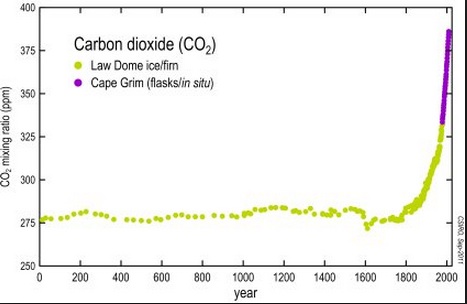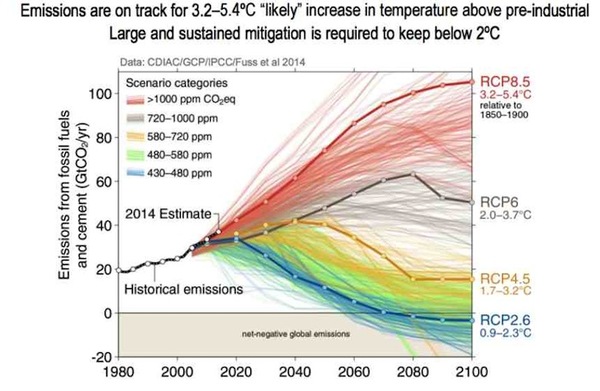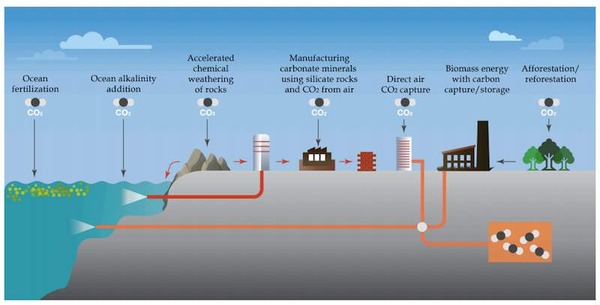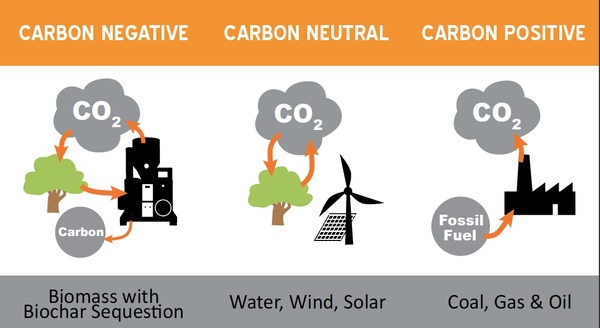Short term and long term, the stakes in getting energy and climate right are daunting and growing for all humanity. The shear volume of carbon we’ve dug up from ancient reservoirs since industrialization and returned to contemporary circulation is difficult to get the mind around. So far we’ve mostly been able to ignore the consequences of this tomb robbing, as the temperature rise from CO2 accumulation lags by decades, if not centuries. However, the historic charts reveal the regularity and predictability for temperature stabilization at various atmospheric CO2 levels, and gives us a looking glass into the disturbing road ahead for our CO2 emission trends.

The charts above show the remarkably close covariance of CO2 levels and temperature over 400,000 years of earth history. To give us some perspective on these dependent variables, note what a 50ppm, 100ppm, 200ppm change in atmospheric CO2 level has meant in temperature changes and sea level rise. Then know that during the vertical blip at the right end of the charts, human activities have raised atmospheric CO2 levels by 125ppm. And we’re continuing to raise it another 2.5ppm or so each year. That’s about 25ppm per decade, or 250ppm per century. And that’s at today’s rates, before we factor in likely future emission rate increases.
This is the first order approximation and understanding we need to grasp. It is an understanding that should scare the pants off us. In climate terms, “CO2 is destiny, all the rest is weather”. We all need to be watching the numbers for CO2 accumulation, not the difficult to distinguish short term temperature and weather changes. Then we need to relate these numbers to what they meant for the earth climate system over many previous cycles of this experiment. That, to an approximation, is where we are going.
In recent millennia, and for most of recorded human history, atmospheric CO2 levels have been a rather boring story. Industrialization, however, completely changed the narrative. What was a flat and uneventful line, has suddenly become an accelerating vertical spike.

Digging a little deeper into the recent spike, we see the shape of this spike closely tracks the growth in our fossil fuel emissions. Note particularly the inflection point around 1950 where personal transport via cars becomes the norm and electrification spreads globally with developing world industrialization. In less than a century, atmospheric CO2 levels have spiked far beyond the long term background fluctuations of the climate system.

Unfortunately, the climate system seldom gives feedback on a timeframe compelling to the human attention span. The rate of change in CO2, temperature, sea level, and terrestrial ecosystems during previous eras happened on geologic timeframes. Now, a hockey stick of CO2 accumulation is happening on the scale of a human lifetime. This still seems too slow a boil to fully gather the attention of humanity.
But consider this: changes to the climate system do resolve and express on multi-decade and single century scales. By 2100, the physics experiment we’re running will have rendered its basic results. The results will look like one of the scenarios below for CO2 levels and temperature rise. Elaborate from the above what this will mean for sea level rises, disruption of natural and human ecosystems, and the lives of 10 billion people.

The world of 2100 is going to look very different than the one we live in today. “Changes beyond our ability to adapt are not out of the question”, in the words of the IPCC. 2100 may seem a long ways off, but it is the same distance ahead as the invention of the automobile is behind us. Or, about one human lifetime newly lived from today.
Repowering the planet with renewables is of course fundamental to averting this disaster. However, even with the recent acceleration of renewables we’re seeing globally, we’re likely to overshoot our targets by non-trivial amounts. Beyond typical renewables like PV and wind, we’re also going to need options to capture and remove carbon from the atmosphere, and bring CO2 ppm back within long term habitable limits.

Multiple scenarios are emerging for carbon negative energy and/or direct CO2 capture and sequestration, though all are early in development, and zero in scaled deployment. Below is a summary of the basic options and pathways available. (Excerpted from the excellent University of Oxford “Stranded Carbon Assets and Negative Emissions Technologies Working Paper“, February 2015)

Biomass based solutions are of unique interest in that the hardest problem — the actual capture and storage of CO2 — is already solved and globally installed at scale in the form of photosynthesis and plants. We don’t have to start from scratch, as in the case of direct air capture of CO2. We only have to process the biomass in some form that prevents the captured CO2 from returning to atmosphere.
Biomass based energy generation has long been considered carbon neutral to an approximation, as the carbon released during combustion was recently removed from the atmosphere to make the biomass. No new carbon is added to the terrestrial and atmospheric carbon cycle, as no ancient fossil carbon is dug up and reintroduced to the cycle.
Carbon negative biomass energy cycles extend this basic carbon neutrality with new features that capture a portion or all the carbon during electricity generation, and prevent its return to atmosphere. Via various means, the captured carbon is sequestered away for long term storage, and thereby removed from the contemporary carbon cycle. You might think of it as the reverse of burning fossil fuels– sucking carbon out of the sky and putting it back in the ground. Active carbon is transformed into inactive carbon, and removed from the climate system.
The Biomass Gasification + Biochar solution uses the charcoal byproduct gasification during power generation, as the carbon store that can be collected and sequestered. Sequestration is much easier than flue stack CO2 gas capture and storage, as char is a solid and easy to handle. Biochar is equally important as a soil amendment, with surprisingly powerful benefits to plant productivity, soil biological activity, water retention, pest management and mineral uptake in plants. And as it is known to be stable in soil for 100s to 1000s of year timeframes, it is a low tech and cheap method for carbon storage, already with a scaled infrastructure via global agriculture. The combination is an unique “win, win win” across energy, agriculture and climate management.
Here’s our new video explaining how it works, why it matters, and what APL is doing to make it real.
Biomass Gasification + Biochar is also unique in that the technology already exists to do it, and various early products are already at market. Today APL and other companies can deliver biomass based Gasification + Biochar machines. While the machines and companies are still new and emerging, there are no fundamental technical or economic barriers that block its potential for scale. Of the competing Negative Emissions Scenarios, Gasification + Biochar has some of the lowest hurdles and greatest potentials for near term scaled deployment. Details on the comparative analysis of options is here: “Stranded Carbon Assets and Negative Emissions Technologies Working Paper“, also referenced above. (yes, we’re encouraging you to read it)


